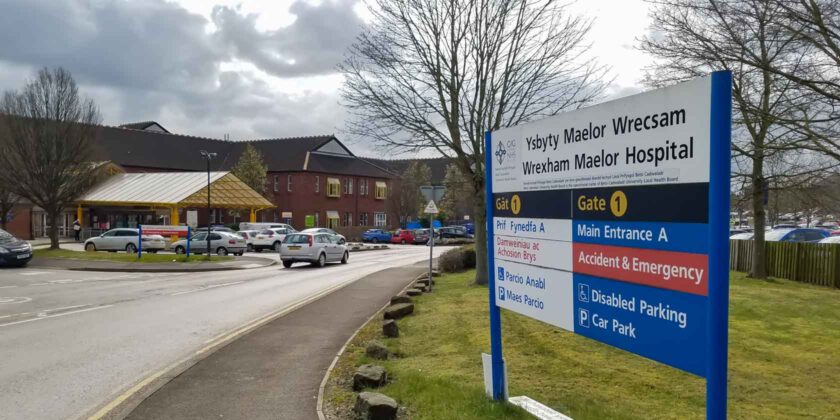New figures reveal worsening A&E wait times at Wrexham Maelor Hospital

Less than 40 per cent of patients who attended the Wrexham Maelor Emergency Department last month were seen within four hours, new figures have revealed.
The data for December, released this week by the Welsh Government, also shows across Wales performance against the four hour target and performance against the twelve hour target both worsened compared with the previous month.
In Wrexham just 39.6 per cent of patients at the Wrexham Maelor Hospital’s Emergency Department were seen within four hours.
This is a drop from 48.4 per cent in the previous month.
December’s figures against the four hour waiting target at the Maelor’s Emergency Department were the worst in Wales for the second month in a row.

95 per cent of new patients should spend less than four hours in emergency departments from arrival until admission, transfer or discharge.
However this Welsh Government target was not met again in December, with 64.8 per cent of patients across Wales seen within four hours.
At the Wrexham Maelor Hospital, 64 per cent of patients spent less than eight hours in the department and 77.6 per cent spent less than 12 hours.
Handover delays at hospitals continue to impact performance across Wales’ emergency departments, with an estimated 25,000 hours in December.
Ambulance response times
In December, 47.6 per cent of emergency responses to immediately life threatening (red) calls arrived within eight minutes of patient location and chief complaint being established.
This was the same as in the previous month.
However it remains well below the Welsh Government’s target of attending 65 per cent of immediately life-threatenings calls – which includes cardiac arrest and those in imminent danger of death – within eight minutes.

According to the Welsh Government the number of green calls has steadily decreased over time, while the number of red calls has continued to rise.
Throughout December there were 6,742 red (life threatening) calls to the ambulance service – the equivalent of 17.7 per cent of all calls.
An average of 217 immediately life-threatening calls were made each day.
This is the highest on record.
Patient pathways
The number of people waiting to start NHS treatment has continued to increase since the coronavirus pandemic.
In November the number of open patient pathways increased from just over 802,100 to just under 802,300.
This is the highest number on record.
The number of open patient pathways is different to the number of individual patients on a waiting list, with some individuals waiting to begin more than one treatment.

Despite this, there was around 619,100 individual patients on treatment waiting lists in Wales during November.
During the same month the number of patient pathways waiting less than 26 weeks for treatment remained at 54 per cent. This has remained steady after falling significantly from pre-pandemic levels.
However the number of patient pathways waiting longer than 36 rose in November to just over 283,000, the second highest figure on record.
Just under 24,400 pathways were waiting more than two years, almost two thirds (65.4 per cent) lower than the peak, but an increase from the previous month.
Response
The Welsh Conservatives have branded the figures as “truly abysmal” and have called on the Welsh Government to tackle the “excessive waits” that patients are facing.
James Evans MS, Welsh Conservative Shadow Cabinet Secretary for Health and Social Care said: “People are dying unnecessarily the length and breadth of Wales, families are losing loved ones prematurely and NHS staff morale is plummeting. Something has to change, because under Labour, the Welsh NHS is broken.
“The Welsh Conservatives will fix the Welsh NHS by ending the distractions and turning the focus of the Welsh Government to tackling these excessive waits, allocating the funding required but ensuring that it is spent efficiently on the frontline as opposed to bloated management structures.”
Plaid Cymru Health Spokesperson, Mabon ap Gwynfor, said: Another month and waiting lists are still going in the wrong direction. The Labour Government have experimented with a series of plans to tackle this scandal all of which have failed.”
“Plaid Cymru has a plan. On day one, we would start the process of establishing elective care hubs, create an executive triage service and use technology, all to get people seen quicker.
“Our short term plan is part of our longer term vision to give the NHS the fresh start it desperately needs. Only a Plaid Cymru Government has real ambition for the future of our NHS.”

Health Minister Jeremy Miles
Responding to the figures Cabinet Secretary for Health and Social Care, Jeremy Miles, said: “The health service in Wales continues to provide quality care to thousands of people every day, in the face of high levels of demand in often challenging circumstances.
“Over the period of this reporting period, we have seen an increase in flu and other winter respiratory illnesses, including COVID-19, which has increased pressure on emergency and urgent care services.
“In November, I increased the amount of funding to target and reduce the longest waits to £50 million to support health boards to provide more treatments, more outpatient clinics and more diagnostic tests. These figures don’t yet reflect this investment.
“Health boards have assured me patients are getting faster treatment as a result and I look forward to seeing the impact of this in the coming months.
“The number of people waiting more than 2 years for treatment is now almost two-thirds lower than at its peak and the number of pathways waiting longer than a year for a first outpatient appointment is also nearly a fifth lower than at its peak in August 2022.
“There were also reductions in long waits for diagnostics and therapies in November.
“In December, the Welsh Ambulance Service reported record levels of immediately life-threatening ‘red’ 999 calls – 13% higher than the previous monthly record. But the average response time was faster than last month.
“Progress continues to be made in reducing the number of delayed hospital discharges.
“This is the fourth month in a row the total number of delays have fallen and December’s figure was the lowest in 2024.”
Spotted something? Got a story? Send a Facebook Message | A direct message on Twitter | Email: [email protected] Latest News








